CSIP: PRELIMS BOOSTER SERIES -492 ART AND CULTURE
VIJAYANAGARA ART
WHY IN NEWS?
The Hindu: Dilapidated well belonging to Vijayanagara era unearthed.
BACKGROUND
Vijayanagar was a kindom that reigned over south India from 1336 to 1565.
TEMPLES
Different temple building traditions in South and Central India were merged into the Vijayanagara architecture style.
It is a vibrant combination and blossoming of the Chalukya, Hoysala, Pandya and Chola styles.
LOTUS MAHAL

Two-story pavilion that, probably functioned as a reception hall or meeting place for the emperor and his advisors.
ELEPHANT STABLES

HAZARA RAM TEMPLE
- Built by Devaraya I in the early 15th century dedicated to Lord Rama.
- Hazara Rama temple is a religious monument was used as a private temple for the king and his private family members.
- It is famous for its intricate carvings that elaborate scenes in the Ramayana (Hindu epic on Lord Rama)
- External walls of the temple are embellished with horizontal panels and sculptured with horses, elephants, cultural events like Dasara, famous stories in Ramayana, etc


Exterior walls Interior panels depicting Ramayana stories
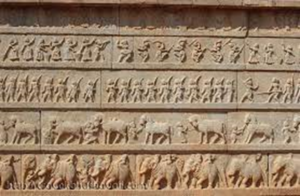
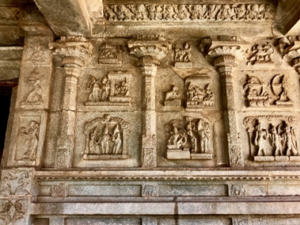
VITTALASWAMY TEMPLE
- It was built during the reign of King Devaraya II (1422 – 1446 A.D.),one of the rulers of the Vijayanagara Empire. Several portions of the temple were expanded and enhanced during the reign of Krishnadevaraya (1509 – 1529 A.D.)
- Dedicated to Lord Vittala an incarnation of Vishnu.
- Main attractions: Stone chariot and 56 Musical pillars


VIRUPAKSHA TEMPLE, HAMPI
- Construction probably began during the reign of Chalukyans of Badami , but was later enlarged and renovated during the Hoysala and Vijayanagar rule
- Dedicated to Virupaksha, a form of Lord Shiva.
- Structure :
- Virupaksha Temple complex is surrounded by three gopuras (towers). The main tower, on the east is an imposing structure, 9 stories, 50 meters tall, built in the fifteenth century.
- It also has a 100 pillared hall/ mandapa, a water tank and smaller shrines.
- The ceilings also contain murals painted during the 16th century.
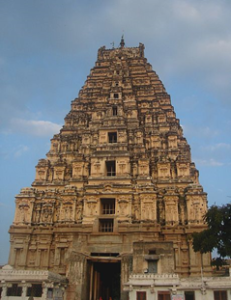
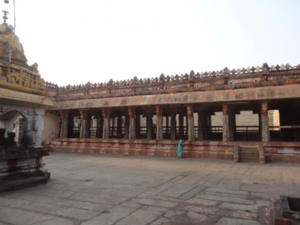

LEPAKSHI TEMPLE ANDHRA PRADESH
- Built during the reign of Achyut Deva Raya.
- Dedicated to Veerabhadra an incarnation of Shiva.
- Features:
- The temple is enclosed by two walls and can be divided into three sections-the Natya Mandapa (dance pavilion) ; the Ardha Mandapa (foyer) and the sanctum and the Kalyana Mandapa (wedding hall).
- The ceilings of the Natya and Ardha Mandapa have several murals illustrating scenes from the Mahabharata, Ramayana and Puranas.
- A gigantic statue of Nandi, also known as Basavanna, is located about 200 mts away from the temple.
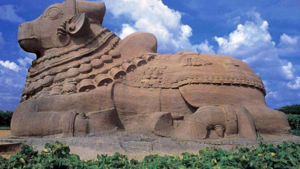
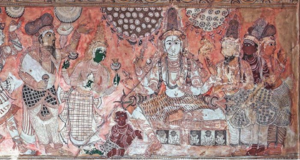


MONOLITHS
- GOMATESHWAR STATUE AT KARKALA, UDUPI

2.SASIVEKALU GANESHA, HAMPI
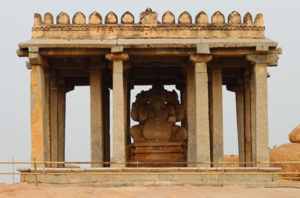
3.URGA NARASIMHA STATUE, HAMPI

LITERATURE
The empire’s patronage enabled fine arts and literature to reach new heights in Kannada, Telugu, Tamil, and Sanskrit.
Krishnadevaraya: Telugu poem Amuktamalyada, Sanskrit works:Jambavati Kalyanam, Rasamanchari.
Teugu:The rule of Krishnadevaraya is known as golden age of Telugu literature. Eight Telugu poets were regarded as eight pillars of his literary assembly and known as Ashtadiggajas (Peddana, Thommana, Tenali Rama)
Sanskrit:
Gangadevi (a royal princess) wote the Sanskrit poem Madur Vijayam.

